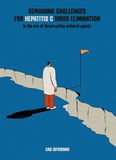Remaining challenges for hepatitis C virus elimination in the era of direct-acting antiviral agents

Isfordink, Cas
- Promoter:
- Prof.dr F.P. (Frank) Vleggaar & prof.dr M. (Marc) van der Valk
- Co-promoter:
- Dr E.P. (Evelien) Mauser-Bunschoten & dr J. (Janke) Schinkel
- Date:
- December 15, 2022
- Time:
- 10:15 h
Summary
Hepatitis C (HCV) is an infectious disease caused by a virus primarily affecting the liver. Approximately 70 to 80% of HCV-infected individuals develop a chronic HCV infection. If left untreated, progressive liver damage results in liver cirrhosis in 20 to 30% of individuals after 20 to 30 year. Individuals with cirrhosis are at risk of developing hepatocellular carcinoma, bleeding of gastroesophageal varices, and liver failure.
Globally, an estimated 58 million persons were living with a chronic HCV infection in 2020. The Netherlands has a relatively low HCV prevalence, with an estimated 23.000 persons ever chronically HCV-infected in 2016. Populations with a relatively high HCV prevalence in the Netherlands are migrants from HCV-endemic countries, mainly in Africa, Eastern Europe and Asia, people with a history of injecting drug use, men who have sex with men, and people with inherited bleeding disorders such as haemophilia. Before 2014, antiviral therapy used for HCV had to be given for six to twelve months, had severe side-effects and a relatively limited efficacy. In 2014, a new type of HCV therapy became available, so-called direct-acting antivirals (DAA). After eight to twelve weeks of treatment with DAA >95% of treated individuals is cured, while side-effects are limited.
Due to the introduction of this effective therapy, the World Health Organisation announced the ambition to eliminate HCV as a global public health threat before 2030. The aim of this thesis was to describe remaining challenges for HCV elimination in the era of direct-acting antivirals.
The thesis consists of three parts, divided into several chapters. Part I focuses on challenges for HCV elimination in people with haemophilia. Chapter 2 is a narrative review describing the history and current situation regarding viral hepatitis in people with haemophilia. In Chapter 3, liver-related complications of long-term HCV infection in people with inherited bleeding disorders are reported, mainly focusing on the setting following successful antiviral treatment. In Chapter 4, the health-related quality of life of people with haemophilia after successful HCV treatment is described and compared with the quality of life of people with haemophilia who were never chronically HCV-infected.
Part II describes challenges for HCV elimination in people living with HIV. In Chapter 5, the prevalence of hepatitis C viremia in people living with HIV in the Netherlands between 2000 and 2019 is described, followed by an analysis of barriers to DAA treatment uptake during unrestricted access. Chapter 6 is an international cohort study in which DAA uptake during unrestricted access was compared between several countries and factors associated with remaining DAA-untreated over time were analysed. In the European, cross-sectional study reported in Chapter 7, data from several cohorts were combined to assess DAA efficacy among individuals with HIV/HCV originating from Sub-Saharan Africa or Southeastern Asia.
Part III concerns challenges for HCV elimination in the Netherlands in general. Chapter 8 is a nationwide retrieval project aiming to re-engage previously diagnosed but lost to follow-up individuals with care. Chapter 9 is a nationwide study aiming to evaluate DAA efficacy and prevalence of resistance-associated substitutions in patients treated for a non-epidemic HCV genotype in the Netherlands. In Chapter 10, current literature regarding liver-related complications following DAA-based HCV eradication in patients with cirrhosis is reviewed and summarised, to determine whether we should continue surveillance for hepatocellular carcinoma and gastroesophageal varices in these patients. Chapter 11 is a modelling study in which the progress towards HCV elimination in the Netherlands is estimated according to several scenarios.
Finally, the general discussion in Chapter 12 discusses the current HCV epidemiology in the Netherlands, remaining challenges for HCV elimination in several key populations as well as the Netherlands in general, and policy changes required to advance HCV elimination in the Netherlands.